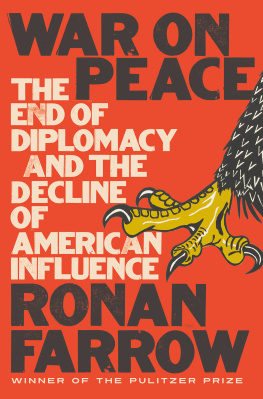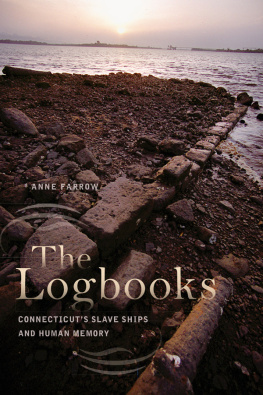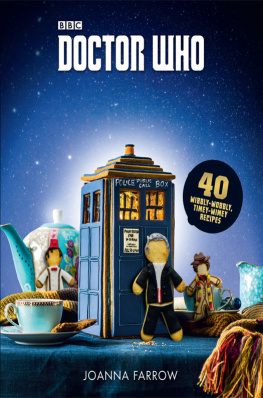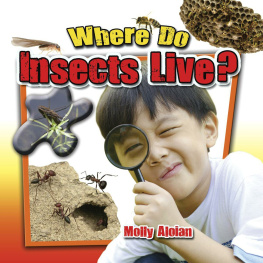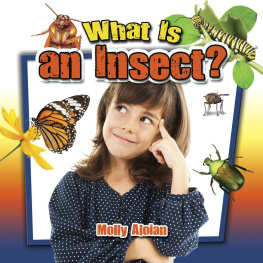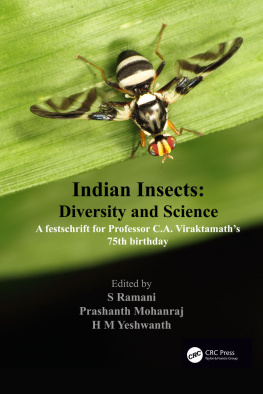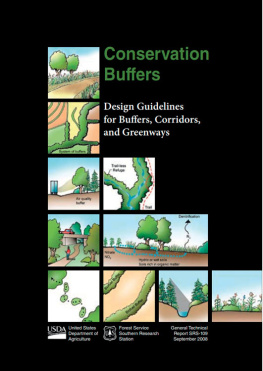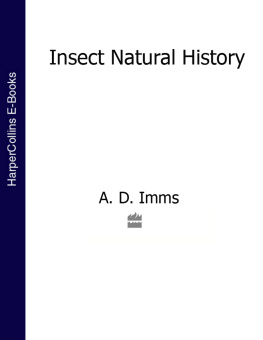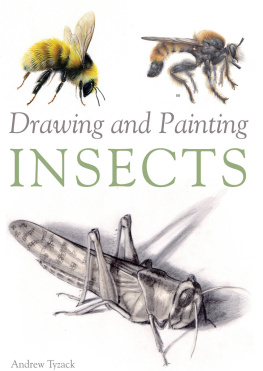This book is dedicated to the late Ernest Lewis, Fellow of the Royal Entomological Society, London, and friend, who introduced me to the fascinating world of beetles
Roger Farrow 2016
All rights reserved. Except under the conditions described in the Australian Copyright Act 1968 and subsequent amendments, no part of this publication may be reproduced, stored in a retrieval system or transmitted in any form or by any means, electronic, mechanical, photocopying, recording, duplicating or otherwise, without the prior permission of the copyright owner. Contact CSIRO Publishing for all permission requests.
National Library of Australia Cataloguing-in-Publication entry
Farrow, Roger, author.
Insects of South-Eastern Australia : an ecological and behavioural guide / Roger Farrow.
9781486304745 (paperback)
9781486304752 (ePDF)
9781486304769 (epub)
Includes bibliographical references and index.
Insects Australia, Southeastern Identification.
Insects Australia, Southeastern Pictorial works.
595.70994
Published by
CSIRO Publishing
Locked Bag 10
Clayton South VIC 3169
Australia
Telephone: +61 3 9545 8400
Email: publishing.sales@csiro.au
Website: www.publish.csiro.au
Cover photographs by Roger Farrow
Images by Roger Farrow except where otherwise credited
Edited by Peter Storer Editorial Services
Cover design by James Kelly
Typeset by Thomson Digital
Printed in China by 1010 Printing International Ltd
CSIRO Publishing publishes and distributes scientific, technical and health science books, magazines and journals from Australia to a worldwide audience and conducts these activities autonomously from the research activities of the Commonwealth Scientific and Industrial Research Organisation (CSIRO). The views expressed in this publication are those of the author(s) and do not necessarily represent those of, and should not be attributed to, the publisher or CSIRO. The copyright owner shall not be liable for technical or other errors or omissions contained herein. The reader/user accepts all risks and responsibility for losses, damages, costs and other consequences resulting directly or indirectly from using this information.
Original print edition:
The paper this book is printed on is in accordance with the rules of the Forest Stewardship Council. The FSC promotes environmentally responsible, socially beneficial and economically viable management of the worlds forests.
Contents

A jewel beetle, Castiarina decemmaculata (Coleoptera: Buprestidae), at Tinderry. Length 10 mm. It is feeding on nectar from a flower of a tea-tree, Leptospermum myrtifolium. There are over 480 colourful species in this endemic genus, making it one of the largest genera of beetles. Several species may coexist feeding on pollen and nectar from the same flowers at the same time, and mating between different species is sometimes observed. Some of the more spectacular species have been over collected and their survival is threatened.
Insects can be the bane of many walks in the bush, whether from the annoyance of the pesky bushfly or the persistent attentions of biting flies, while our gardens are often a source of mosquitos that drive people inside at dusk. On the other hand, such walks can reveal a whole new world of insect diversity, species richness and intriguing adaptations through camouflage, mimicry, feeding mechanisms and many other attributes. Insects may be visiting flowers, patrolling the air, feeding on plants or just hanging about, but whatever they are doing there is a story to tell. I have attempted to tell these stories in this guide, which starts with the feeding strategy and behaviour of the target insect in its natural setting, rather than the appearance of the insect itself. The guide is directed towards anyone with an interest in the rich natural history of insects in south-eastern Australia, including bushwalkers, natural historians, environmentalists, land care and conservation groups, gardeners and educators, among others, as well as entomologists. Although the fieldwork for this guide has been mainly conducted in the Southern Tablelands of NSW and adjacent ranges, most of the insects covered have a much wider range in south-eastern Australia and beyond. I hope that users of this guide will find this approach to insect identification easy to use and more eco-friendly than the traditional method of catching and preserving insects for later identification.
The diversity of insects in any particular area is also an indication of the quality and conservation value of that environment because so many ecological processes depend on insect activity, whether it is pollination of flowers, recycling of nutrients or providing food for vertebrates, such as birds and reptiles. Insects rarely receive the recognition they deserve as indicators of the conservation values of different habitats, compared with vertebrates and plants, and this guide is also an attempt to raise the profile of insects in the environment.
As the saying goes, a picture is worth a thousand words, so an emphasis is placed on the photographs of insects behaving in their natural environment with the identity of host plants given, where relevant, as well as the location (see encountered in our area in a particular feeding group and family, and will usually provide a genus and common name, and possibly a species name.
Roger Farrow, Tilembeya, June 2015

A spectacular jewel beetle Stigmodera macularia feeding at flowers of a bearded heath Leucopogon muticus. Length 25 mm. Lithgow, New South Wales. This beetle was described in 1805 in Insects of New Holland by Edward Donovan from insects collected by Joseph Banks or William Bayley on one of the three Cook Expeditions. Donovan personally engraved and hand coloured his prints.
Insects are normally identified from collected, preserved and labelled specimens and it is often much more difficult to name a species from a photograph that may not show the characters required for a formal identification. However, I would like to thank all the colleagues that looked at my photographs and helped identify many insects.
To David Rentz for grasshoppers, crickets, and cockroaches; Paul Brock for stick insects; Graham Milledge for mantids, Gunther Theischinger for dragonflies and stoneflies; Penny Gullan for scales and their allies; Murray Fletcher for leaf hoppers and their allies; Max Moulds for cicadas; Gerry Cassis for true bugs and earwigs; Tim New for lacewings; Chris Reid for leaf beetles; Dan Bickel, Neal Evenhuis, David Ferguson, Stephen Gaimari, Martin Hauser, Christine Lambkin, Bryan Lessard, Michaela Purcell, Gunther Theischinger and David Yates for different flies; Alice Wells for the caddisfly; Ted Edwards and Michael Braby for moths and butterflies; Marina Tyndale Biscoe and John Feehan for dung beetles; Ken Walker for bees; Bruce Halliday for the mite, and Mark Harvey for the scorpion and false scorpion. Particular thanks are due to Kim Pullen for beetles, flies, wasps and many others and for his expert knowledge about the local insects. Any errors of identification that remain in the book are mine.
Additional photographs have been supplied by Denis Anderson, Martin Butterfield, Nony Edwards, Ted Edwards, Esther Galant, Penny Gullan, Christine Kendrick, Diana Mortimer, Stewart Needham, Adrienne Nicholson, Stef Oberprieler, Rod Peakall, Kim Pullen, Linda Rogan, Janet Russell, Philip Spradbury, Ken Walker, Denis Wilson and Tony Wood. The photographic opportunities were greatly aided by my friends at the Native Plant Society of Canberra on our weekly forays and monthly field trips when many interesting insects were drawn to my attention.
Next page

